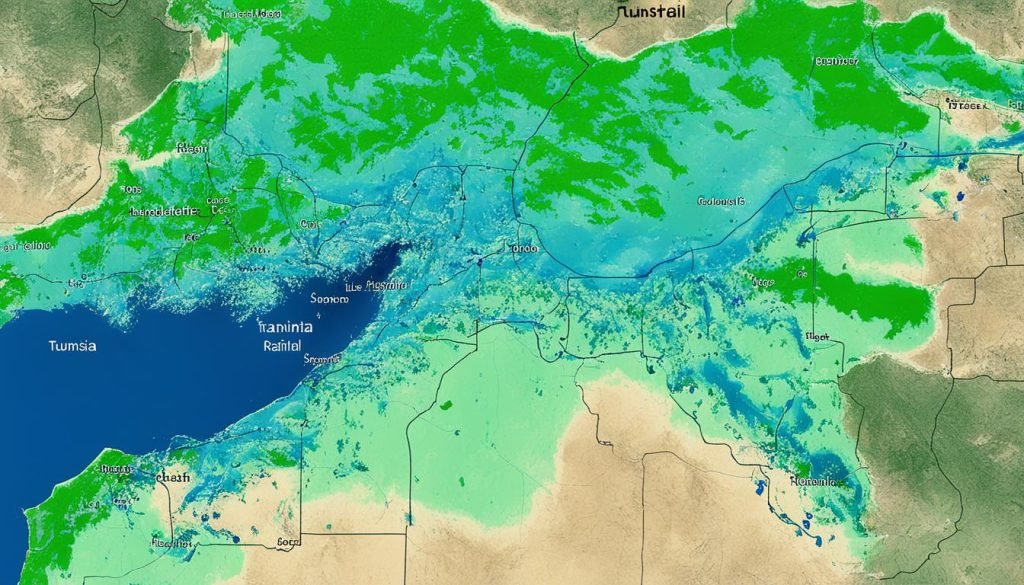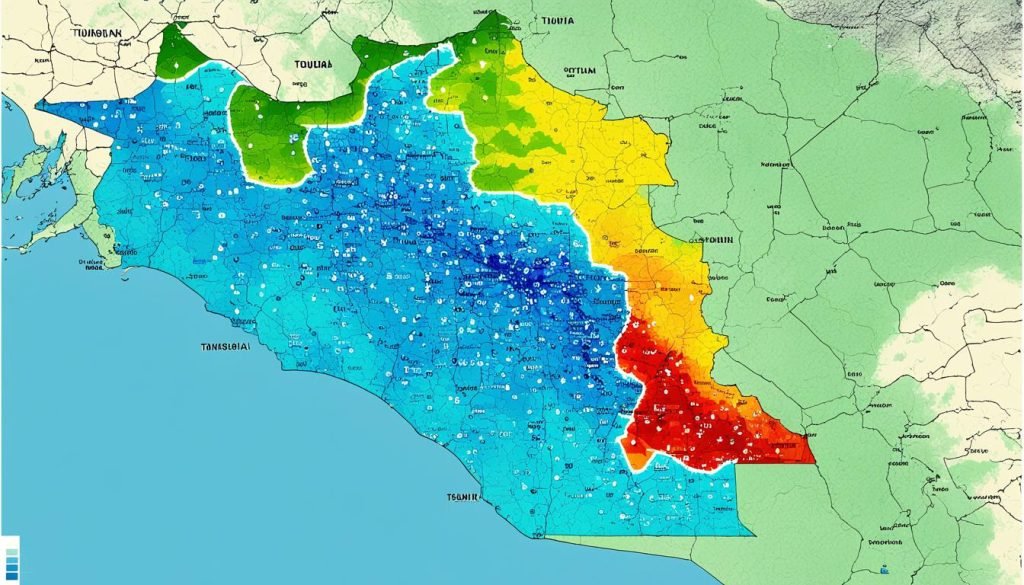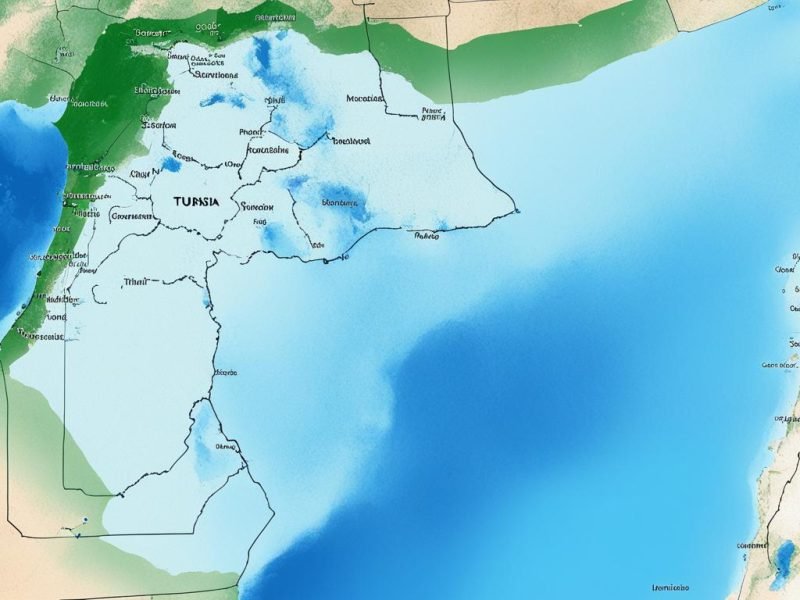If you’re wondering about the Tunisia climate and Tunisia weather patterns, you might find it interesting to learn about the variety. Asking, “Does Tunisia get a lot of rain?” opens up a complex discussion. In Tunisia, the weather varies greatly. The north enjoys rainy winters and warm summers thanks to the Mediterranean. But in the south, the Sahara Desert makes it very dry.
The average Tunisia precipitation levels might not tell the whole story – 158 millimeters a year seems simple. But it’s more complex. The south gets less than 100 millimeters of rain a year, while the north can receive over 700 millimeters. Temperatures also range widely. The north has mild winters and hot summers. The central and southern areas see temperatures from cool to very hot.
Key Takeaways
- Tunisia’s climate varies significantly, with the Mediterranean north contrasting with the semi-arid south.
- Annual rainfall in Tunisia is misleading without regional context—the north can see over 700mm, while the south receives under 100mm.
- Understanding Tunisia’s weather patterns is essential for grasping the regional disparities in precipitation levels.
- Extreme weather events, such as coastal flooding and droughts, underscore the variability of Tunisia’s climate.
- Temperature range further illustrates the climatic divide, coupling chilly winters with exceedingly warm summers.
Understanding Tunisia’s Varied Climate Zones
Tunisia’s landscape brings many different types of weather. From the steady Tunisia Mediterranean climate in the green north mountains to the tough desert conditions in the south. This variety is not just interesting for scientists but also affects everyday life and farming across Tunisia.
In the north, the weather brings enough rain, especially in Bizerte. Here, the rain can reach up to 650 mm a year. But in southern places like Tozeur, it’s very dry, with less than 100 mm of rain annually. This shows just how different the weather can be.
On the eastern coast, cities like Sousse and Sfax have semi-dry climates. Rainfall there is between 330 mm and 200 mm. These differences clearly show how Tunisia’s geography shapes its weather.
| Region | Climate Type | Average Annual Rainfall (mm) |
|---|---|---|
| Bizerte (North) | Mediterranean | 650 |
| Tozeur (South) | Desert | 100 |
| Sousse (East Coast) | Semi-arid | 330 |
| Sfax (East Coast) | Semi-arid | 200 |
Analyzing Tunisia’s Rainfall Patterns
Looking into Tunisia’s climate shows a landscape deeply influenced by regional weather patterns. It’s crucial for farming or travel within this varied country.
Northern Tunisia: A Mediterranean Climate with Seasonal Showers
In Northern Tunisia, places like Bizerte and Tunis have a Mediterranean climate. This climate gives moderate rainfall, great for the rainy season. Tunis gets about 485 mm of rain a year, mostly from autumn to spring.
These showers support agriculture, helping crops grow during wet months. But the summers are very dry, with temperatures over 40°C. This shows the areas’ complex weather.
Coastal Variability: Rainfall from North to South
As you move south along Tunisia’s eastern coast, the rainfall pattern changes. The weather shifts from Mediterranean in the north to semi-arid in the south. For example, Sousse gets around 330 mm of rain yearly, and Sfax gets even less, about 200 mm.
This drop shows the clear coastal weather changes. These changes affect people’s lives and work.
Inland and the South: Encountering Semi-arid and Arid Climates
Heading inland and south, the climate becomes more arid. Places like Tozeur get very little rain, around 100 mm a year.
This area faces extreme temperatures, with very hot days in summer and sometimes freezing nights in winter. This highlights Tunisia’s desert climates.
Here’s a look at the differences in rainfall and temperature from north to south in Tunisia:
| Region | Annual Rainfall (mm) | Average Summer Temperature (°C) |
|---|---|---|
| Tunis (North) | 485 | ~40 |
| Sousse (Central) | 330 | ~35 |
| Sfax (South) | 200 | ~38 |
| Tozeur (Deep South) | 100 | ~40 |
This information showcases how rainfall decreases and temperature increases as one moves south. The weather changes in Tunisia pose distinct challenges for the region’s lifestyle and economy. Understanding these weather patterns is key for planning and adapting effectively.

Tunisia’s Geographical Impact on Precipitation
Understanding how Tunisia’s geography affects its climate is key. The country’s diverse landforms play a big role in rainfall distribution. In the north, mountains catch moist air from the Mediterranean, leading to more rain. But in the southern deserts, rain is much less common.
The changing Tunisia climate impacts many areas of life, like farming and city planning. The north’s lush areas support various crops, boosting the agricultural sector. The dry south, however, lives a simpler life with limited farming, relying on the rare rain or man-made watering systems.
| Region | Average Annual Precipitation | Primary Influences |
|---|---|---|
| Northern Tunisia | 450-600 mm | Mediterranean influence, frequent seasonal rain |
| Southern Tunisia | <100 mm | Arid desert conditions, rare precipitation |
These differences show how Tunisia’s geography leads to contrast in precipitation levels. It affects the lives and economies of the people. From the fertile north to the dry south, the climate varies greatly. These conditions stress the need for tailored approaches in farming, water use, and city planning in Tunisia.
Does Tunisia Get A Lot Of Rain?
Let’s dive into Tunisia’s rainfall and weather patterns. These insights show how different factors impact the climate. The country’s unique landscapes cause varied rain patterns. These are essential for farming and city design.
Exploring Regional Precipitation Data
In cities like Tunis, Tunisia rainfall is moderate but changes with the seasons. The capital gets about 485 mm of rain spread across 84 days a year. This fact highlights the importance of knowing local weather, not just general stats.
Seasonal Rainfall Distribution across the Country
The Tunisian rainy season runs from October to March, with the most rain in December. The dry season follows, with a big drop in July. These patterns are key for managing water and farming in Tunisia.
| Month | Average Rainfall (mm) | Rainy Days |
|---|---|---|
| January | 95 | 12 |
| February | 76 | 11 |
| March | 58 | 10 |
| April | 49 | 9 |
| May | 31 | 7 |
| June | 13 | 4 |
| July | 5 | 2 |
| August | 7 | 2 |
| September | 43 | 5 |
| October | 65 | 7 |
| November | 66 | 8 |
| December | 88 | 10 |

Adaptation and Considerations for Tunisia’s Rainfall
In Tunisia, Tunisia weather patterns and Tunisia dry seasons shape how people farm and welcome tourists. Both agricultural planning in Tunisia and Tunisia tourist planning must consider the changing Tunisia rainfall. Let’s explore these adaptations.
Agricultural Implications of Variable Rainfall
Rainfall changes greatly affect farming in Tunisia. In the north, more rain means a variety of crops can grow. But in the south, it’s drier.
Here, farmers must use creative ways to water crops and save water. Understanding Tunisia weather patterns is key to growing food in these places.
Travel and Tourist Planning Around Weather Patterns
Tunisia’s tourism adapts to its weather too. Beach vacations on the east coast are best from June to September. This is when it’s sunniest.
In the spring and fall, the rainy and cooler north coast and hills are great places to visit. And the southern deserts? Winter is the best time to go there to avoid the summer heat.
Whether farming or traveling, knowing Tunisia’s varied weather is vital. It helps with productive farming and ensures tourists have a good and safe time in this diverse country.
Conclusion
Tunisia’s climate is as varied as its landscapes. The north enjoys a rich Mediterranean climate with lots of rain. This supports fertile lands and affects the local lifestyle and culture. On the other hand, the south faces a harsher, drier climate thanks to the Sahara, making rain scarce.
The weather in Tunisia deeply impacts its agriculture and economies. Understanding the climate helps grasp the country’s agricultural cycles. With weather swinging from heavy rains to dry periods, Tunisians have adapted over time. This adaptation has shaped Tunisia into a place rich in history and modern vibrancy.
For tourists, knowing about Tunisia’s weather is key to planning a trip. They can enjoy the mild winters of the Mediterranean coast or the desert’s cool winters. So, whether you’re into farming, culture, or travel, Tunisia’s climate plays a big role in the country’s way of life.







